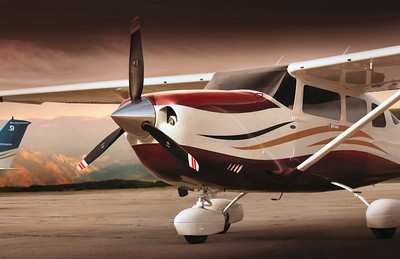Cessna 206 Ditched In Lake Michigan, Four People Were Fatally
Injured
 The pilot of a medical flight on
its way to Rochester, MN was the only survivor when he was forced
to ditch the Cessna 206 he was flying in Lake Michigan following an
apparent engine failure. The NTSB reports that the engine of the
plane was separated by the force of the impact, but was recovered
and has been sent to its manufacturer for analysis.
The pilot of a medical flight on
its way to Rochester, MN was the only survivor when he was forced
to ditch the Cessna 206 he was flying in Lake Michigan following an
apparent engine failure. The NTSB reports that the engine of the
plane was separated by the force of the impact, but was recovered
and has been sent to its manufacturer for analysis.
NTSB Identification: CEN10FA465
14 CFR Part 91: General Aviation
Accident occurred Friday, July 23, 2010 in Ludington, MI
Aircraft: CESSNA 206, registration: N82531
Injuries: 4 Fatal, 1 Minor.
This is preliminary information, subject to change, and may
contain errors. Any errors in this report will be corrected when
the final report has been completed.
On July 23, 2010, at 1017 eastern daylight time, a Cessna 206,
N82531, sustained substantial damage when it was ditched in Lake
Michigan about 5 miles west of Ludington, Michigan, after a
reported loss of engine power. The 14 Code of Federal Regulations
Part 91 personal flight departed the Gratiot Community Airport
(KAMN), Alma, Michigan, at 0850 en route to Rochester International
Airport (KRST), Rochester, Minnesota. The airplane was over Lake
Michigan at 10,000 feet msl when the engine lost power. The pilot
reversed course but was unable to reach the shore, and he ditched
the airplane. The pilot survived and was rescued by a fishing boat
about 38 minutes later. The pilot rated passenger and three other
passengers did not survive. Visual meteorological conditions
prevailed at the time of the accident. An instrument flight plan
was filed.
The pilot reported that the purpose of the flight was to take
one of the passengers to the Mayo Clinic in Rochester, Minnesota.
The flight was a personal flight and was not associated with a
charity organization. The patient and his wife were seated in the
aft seats, seats 5 and 6. The patient’s doctor was sitting in
the middle row in seat 3 on the left (Seat 4 had been removed). The
pilot was in the left front seat and the pilot rated passenger was
in the right front seat, seat 2. The fuel tanks were filled to
capacity the night before the flight. He reported that after
climbing to 10,000 feet msl, he leaned the fuel mixture to
approximately 14 gph.
All the instrument readings were within normal limits as they
crossed the shore near Ludington, Michigan. The head winds were
about 40 knots “directly on the nose.” About mid-point
over the lake, the engine began to misfire and lose power, with the
fuel flow dropping to about 11 gph. The pilot attempted to regain
power by pushing in the mixture control to full rich but without
effect. He contacted the Minneapolis Air Route Traffic Control
(ARTC) and reported that the airplane was losing power, and he
reversed course toward the Michigan shoreline. The fuel flow
dropped to about 8 gph. The pilot switched fuel tanks and adjusted
the mixture control in and out to try to regain power. He reported
that he turned on the high boost pump and got a short burst of
power for about 30 – 45 seconds, but then the engine
“failed completely.”
The airplane descended through a cloud layer. The pilot reported
that they had a few minutes before water impact after breaking out
of the clouds, so he had everyone don and inflate their life vests.
Before impact, the pilot unlatched the pilot’s door on the
left side of the airplane, and he had the front door of the rear
cargo door unlatched. The pilot reported that he did not lower the
flaps since the cargo doors would not open if the flaps were
extended.

Cessna 206 File Photo
The pilot reported that when he ditched the airplane, either the
tail or the landing gear hit a swell as he pulled up to go over a
swell. The airplane pitched forward, flipped over on its back, and
began to fill with water. The pilot unbuckled his seat belt and
shoulder harness, fell a short distance, pushed the door open, and
got out. He reported that the airplane was sinking rapidly. He saw
the right seat passenger and the doctor in the water. A wave hit
the pilot and when he resurfaced, “everything was
gone.” He kept yelling but got no response. He eventually
started to swim toward the shoreline. About 30 minutes later a US
Coast Guard helicopter flew over him but they did not spot him. A
few minutes later a fishing boat spotted him and rescued him from
the water. He was transferred to a Coast Guard vessel and was taken
to shore.
Using their side scanning sonar, the Michigan State Police Dive
Team located the airplane in about 173 feet of water on July 30.
The dive team recovered all the bodies, with the last body being
recovered on the morning of August 1, 2010.
The airplane and engine were separated by the water impact. Both
were raised to the surface by a local commercial recovery service
on August 1, 2010. The airplane and engine were taken to a local
facility where the National Transportation Safety Board conducted
its on-site investigation. The engine was shipped to the engine
manufacturer for further inspection.
 ANN's Daily Aero-Linx (05.06.25)
ANN's Daily Aero-Linx (05.06.25) ANN's Daily Aero-Term (05.06.25): Ultrahigh Frequency (UHF)
ANN's Daily Aero-Term (05.06.25): Ultrahigh Frequency (UHF) ANN FAQ: Q&A 101
ANN FAQ: Q&A 101 Classic Aero-TV: Virtual Reality Painting--PPG Leverages Technology for Training
Classic Aero-TV: Virtual Reality Painting--PPG Leverages Technology for Training Airborne 05.02.25: Joby Crewed Milestone, Diamond Club, Canadian Pilot Insurance
Airborne 05.02.25: Joby Crewed Milestone, Diamond Club, Canadian Pilot Insurance




